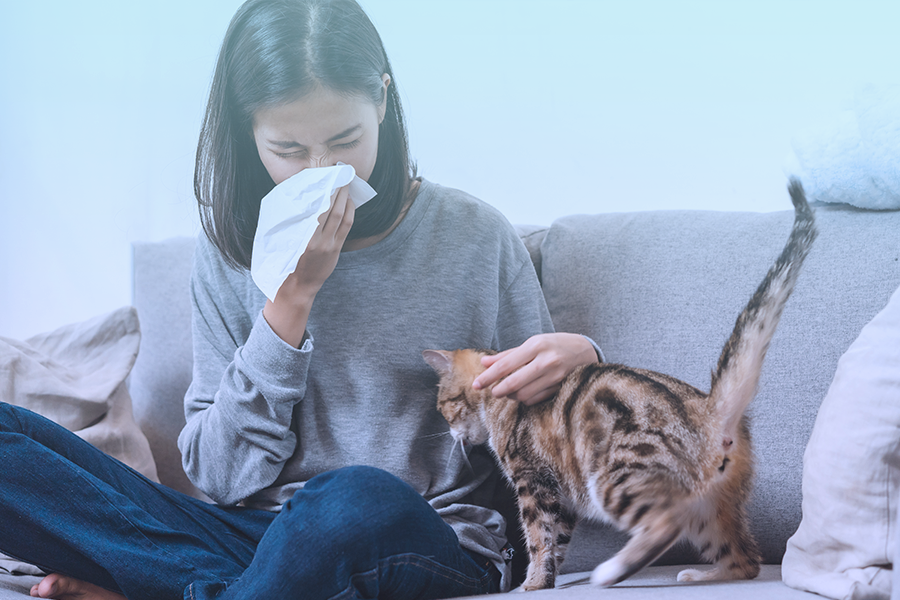Breathe Freely

Are At-Home Allergy Tests Worth It?
If you’re hoping to test for environmental allergies but don’t want the hassle of going into the doctor’s office, an at-home allergy test is a great option for you. Quello’s at-home tests are convenient, accurate, and best of all — free!
We know how frustrating it is when allergies interfere with your daily life, and we’re sure that the last thing you want is another visit to the doctor’s office. That’s why Quello’s allergy specialists are here to break down the basics of at-home allergy testing: how it works, whether it’s truly reliable, and plenty more.
Let’s dive in!

Do At-Home Allergy Tests Work?
The short answer: For environmental allergies, yes!
At-home allergy tests can reliably determine which environmental allergens you’re sensitive to. However, it’s worth keeping in mind that at-home testing isn’t as dependable for revealing food allergies — so it’s best to exercise caution when considering at-home food allergy tests.
Here are some common environmental allergens that at-home tests are awesome for:
- Trees
- Weeds and grasses
- Dander from dogs, cats, and other types of animals
- Cockroaches
- Dust mites
- Mold
At-home allergy tests aren’t quite as robust as in-person tests. If you have severe allergies that are disrupting your sleep, work, and exercise routines, it may be best to consult with an allergy specialist.
If, on the other hand, you’re looking to conveniently analyze a panel of pesky environmental allergens, at-home testing is worthy of serious consideration.
How Do At-Home Allergy Tests Work?
At-home allergy tests, like the ones we use at Quello, test for an antibody called immunoglobulin E (IgE).
Heightened levels of IgE in your immune system indicate that you’re sensitive to certain environmental allergens. With Quello’s advanced allergen-specific testing, we can even uncover which exact allergens are problematic for you!
To get a better understanding of how these tests work reliably, let’s do a quick crash course on the science behind allergies.
The Science Behind Allergies, In a Nutshell

Let’s imagine that you’ve returned from a meeting at work, a child’s birthday party, or the gym (really, anywhere that germs run rampant). Inevitably, some of those germs will sneak into your body. When that happens, your immune system produces antibodies, which are specialized proteins that target and destroy disease-causing germs.
So, what do allergies have to do with it? Well, sometimes your immune system mistakenly identifies a substance, such as pollen or pet dander, as harmful — even though it really isn’t! In those cases, your body develops antibodies like IgE to fight off the substance, resulting in those frustrating, all-too-familiar allergy symptoms:
- Sneezing
- Coughing
- Runny nose
- Congestion
- Itchy, watery eyes
- Headaches
- Fatigue
- And many more
At-home allergy tests hone in on the levels of allergen-specific IgE in your blood, revealing which allergens are causing your body to overreact.
How to Do an At-Home Allergy Test
Thankfully, at-home allergy testing is simple!
Though every at-home test is a little different, most will follow the same steps as our Quello tests:
- Use the tool in the testing kit to prick your finger (just once, we promise!).
- Add a few drops of blood to the sample card provided.
- Return the sample card in the labeled envelope.
Easy-peasy, right? Once we receive your results, we’ll get to work on a personalized treatment plan, including allergy drops that are created just for you.
Types of At-Home Allergy Testing
When it comes to allergy testing, it can be hard to separate research-backed facts from wishful thinking. Here’s a breakdown of some common types of allergy testing, what they’re used for, and whether they’re trustworthy.
| Allergy Test Type | How It Works | What It’s Used For | Trustworthy? |
|---|---|---|---|
| Blood | Analyzes the levels of IgE antibodies in your bloodstream | Environmental allergies | Yes |
| Hair | In theory, detects patterns of electromagnetic resonance | Food allergies — but this test is not scientifically proven | No |
| Urine | Checks for histamine, a mediator of allergic reactions | Determining the severity of a person’s allergic reaction and potentially detecting the presence of food allergies | Yes, pending more research |
Pros and Cons of an At-Home Allergy Test
Pros of At-Home Testing
- Convenience: You can complete an at-home test whenever it’s best for you — no scheduling conflicts or awkward waiting rooms.
- Transparent pricing: When you buy a test online, you know upfront exactly what you’ll pay. It can be hard to figure out the precise cost at a clinic, and navigating the insurance process can be even more painful.
- Ease-of-use: At-home tests have clear instructions and testing typically takes just a few minutes.
Cons of At-Home Testing
- False positives: Some at-home tests inspect a broad range of potential allergens, increasing the chance of false positives. Quello tests are specifically designed to test for certain common allergens, minimizing the risk of a false positive.
- Lack of context: If your results are inconclusive, having a specialist to discuss them with is especially helpful. While Quello offers online support from friendly experts, some people prefer to meet for an in-person discussion.
- Variance in test quality: Some at-home tests look only at IgG, which isn’t as effective as examining IgE for allergy sensitivities.
Is an At-Home Allergy Test Right for Me?
To decide whether at-home testing is a good fit for you, ask yourself these questions:
- How busy is my schedule? At-home tests are perfect if you can’t find a spare minute during the work day to visit the doctor’s office.
- How quickly do I need results? Often, you have in-person test results before you leave the clinic; at-home tests take longer to arrive at the lab for interpretation.
- Is an in-person conversation important to me? If you’re hoping to chat face-to-face with an allergy specialist, heading into the clinic is a good call.
- What type of test do I want? Some clinicians will puncture your skin as many as 40 times to test a wide range of substances. At-home tests require only one skin prick!
If you’re a busy professional (or simply a parent who’s rushing from place to place all day), an at-home test could be a smart starting place on your journey to overcoming your allergies.
Overcome Your Allergies At Home With Quello
We get it — allergies are the worst. Thankfully, testing for them doesn’t have to be. Quello’s at-home allergy tests are safe, effective, and easy.
Here’s all there is to it:
- Complete your blood sample test in the comfort of your own home.
- Send it our way, and we’ll create personalized allergy drops just for you.
- Take your drops daily — then begin to enjoy the freedom of allergy-free life.
The best part? Our testing kit is free!

FAQs
Are at-home allergy tests effective?
Though at-home allergy tests aren’t great for revealing food allergies, they’re an excellent option for determining your sensitivity to environmental allergens (pollen, dust, mold, etc.). Quello tests check for the presence of specific IgE antibodies to isolate the exact cause of your allergies.
Does insurance cover at-home allergy tests?
Some private insurances will help to cover the cost of your allergy testing kit. If you have questions about insurance, contact our experts — we’re happy to help!
Can you test negative for allergies and still have them?
It is possible to have no reaction to a substance that you are allergic to (in other words, to receive a false negative). Most of the time, though, a negative test result means that you aren’t suffering from that specific type of allergy.
How do you know if your at-home allergy test is positive?
After completing your at-home allergy test, you’ll send the sample card in for laboratory testing. From there, an allergy specialist will review and interpret your results.
Are at-home allergy tests worth the money?
For many people, the convenience and pricing transparency of at-home allergy tests is worth the cost. At Quello, we offer a free allergy testing kit!
Overcome your allergies at home with our doctor-led therapy.
Get started with our free allergy test kitGet Started with no test needed.
Overcome your allergies at home with our doctor-led therapy.
Get started with our free allergy test kitGet Started with no test needed.



